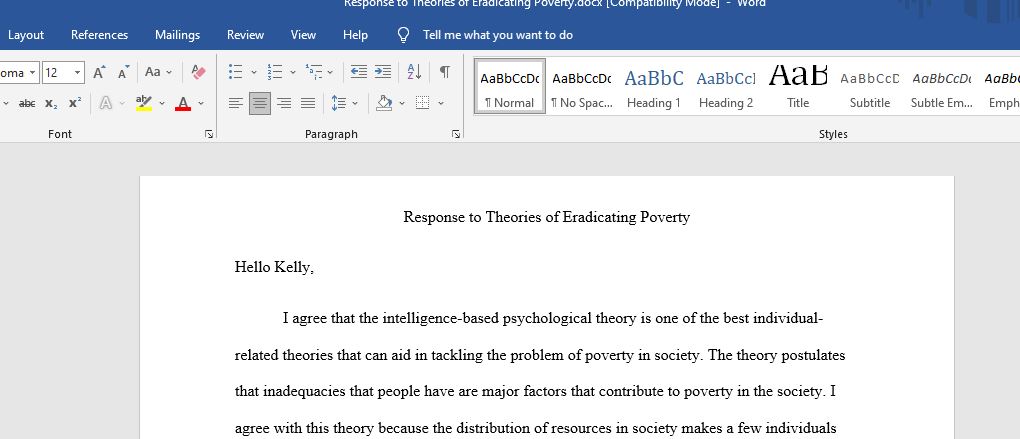Individual vs Structural-Cultural Theories Response
Respond to at least two colleagues:
- Evaluate one identified strength and one identified limitation your colleague may encounter when employing an individual-related theory and a structural/cultural-related theory to formulating interventions for poverty.
Colleague 1: Kelly
For my individual related theory on poverty, I choose Intelligence-based psychological theory. This theory states that people’s deficiencies contribute to an individual living in poverty. By reading about this theory, I found out that a second premise is that people living in poverty just simply do not have the desire to succeed. I can see some validity in this theory. However, I believe that there is so much more that causes poverty. I do not believe that it is any one thing and it very well could be several things. I believe that the cause of poverty can differ from one person to the next. I know that it is very difficult to make it out of generational poverty because with this type of poverty it is a lifestyle.
For my structural/culture-related theories, I choose the ecologically- based theory. With this theory it focuses on the social environment and pays special attention to the person’s resiliency. The theory works with public policies that aids in the eradication of poverty. Equal public education, living-wage jobs and affordable house are three ways that this policy hopes will help in eliminating poverty.
A social worker would conceptualize the problem of poverty by looking at both the individual related theory on poverty as well as the structural/culture-related theories. I believe that it would be difficult to focus on one without the other. Afterall, we must look at the individual and how they see themselves while being able to focus on society and how they are view by others.
By focusing on the individual related theory of poverty, we can see how our client views themself and gain some insight into their life. By focusing on the individual theory, we can see what it is like for the person that lives in poverty. The structural/culture-related theory must be looked at as well. This theory will give us insight on what programs are in place to help the person living in poverty become more resilient.
By focusing on both theories, we can see clearly what make our client so resilient. At the same time, we can see how they are struggling. By looking at the individual theory, we can then focus on the structural/culture-related theory in hopes of lifting some of their burden.
Turner, K., & Lehning, A. J. (2007). Psychological theories of poverty. Journal of Human Behavior in the Social Environment, 16(1/2), 57–72. doi:10.1300/J137v16n01-05
Colleague 2: Allison
Class,
For my individual theory, I chose the intelligence-based theory. This theory lays out that each person has deficiencies that contribute to their poverty level (Turner & Lehning, 2007). The classic response to poverty a lot of times is that people are poor because they are not intelligent and that they have no motivation to do help themselves succeed. I personally do not agree with this. Working with low-income and homeless families I’ve found that their situation is the result of layers of hardships, barriers, and personalities. I agree that there are some people who have a lower intelligence level than others which can be a contributing factor to the poverty problem, however, I do no think it is singled out to be just that. I think that intelligence can play a huge role in other classes of people which can cause parallel barriers. Because there are so much complexity and diversity amongst the world, it is hard for me to believe that intelligence can be pinpointed to be the sole problem.
For my structural theory, I chose globalization and the Empowerment Theory that Moreira suggests is the biggest influence on the life of poverty; this idea is all about the environment and how capitalism has created what we know as wealth and poverty (Turner & Lehning, 2007). She continues on to explain that information networks are no distributed equally and are selected to reach the wealthier communities and exclude poorer segments of societies (Turner & Lehning, 2007).To further this concept, the Empowerment Theory says that those lower-income, excluded regions also lack political and psychological power I do believe that this theory about how poverty is sculpted over time is accurate. I also believe that once those societies and economies are deemed to be poor they continually get poorer because they’re continued to be excluded making the economic gap even larger. It was suggested by Turner and Lehning (2007) that three things are to be given to every citizen: political, economic, and social freedom; security and protection; and transparent governmental activities. I truly believe that starting with these three principles we could start to see a shift in the way poverty looks and who is considered to be in poverty.
These two theories differ because the individual-related theory puts the blame on the individual and what they are doing right or wrong. The structural -related theory puts the blame on society and what they decide to give to certain people and in what way. I think it is interesting to look at these theories because each supports the view people express and work from. We have to be able to conceptualize the problem of poverty not only by first looking at the micro-level but then putting that in context with the macro level and the way society looks around them. By focusing on both theories we can see why our clients are as resilient or intelligent or savvy as they are while being able to compare that to what is working with or against them.
-Allie-
Turner, K., & Lehning, A. J. (2007). Psychological theories of poverty. Journal of Human Behavior in the Social Environment, 16(1/2), 57–72. doi:10.1300/J137v16n01-05
Answer preview:

word limit:614
